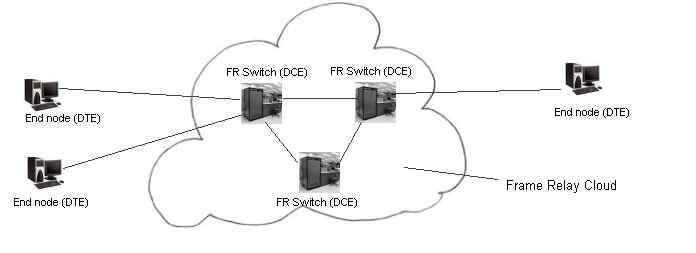A Frame Relay (FR) network is shown in the figure below. An FR network may be considered as a FR cloud that consists of FR switches, and customer nodes. A FR switch acts as DCE and the customer equipment works as DTE. A virtual circuit is established between the DTE and corresponding DCE. As mentioned earlier, a virtual circuit is identified by a DLCI (Data Link Connection Identifier) number. DLCIs have local significance. It means that on a given physical channel, there can not be two DLCIs which are identical.

Frame Relay is essentially a packet switched network, and can be compared with an X.25 network. Though both Frame Relay and X.25 use same basic protocol HDLC, there are several differences between the two. Some of the important differences between a Frame Relay network and and X.25 network are given below:
| Feature | X.25 | Frame Relay |
| Basic frame protocol used | HDLC | HDLC |
| Typical Speed (bandwidth) | Low | High |
| Interactive sessions | Barely suitable | Suitable |
| LAN connectivity for fast file transfers | Not suitable | Suitable |
| Protocol Overhead | High | Minimal |
| Protocol complexity | High | Low |
| Voice support | Poor | Good |
| Error Correction | Very good | Not supported |
| Comments | 1. X.25 is a very old protocol, and widely implemented.
However, it is hard to find any new implementations. 2. X.25 implements node-to-node error correction, and very suitable for noisy circuits. A severe drawback is high overhead, and transmission delays. |
1. Frame Relay is widely implemented these days. Frame Relay
does not support any node-to-node error correction. With the advent of
highly reliable physical channels, node-to-node error correction (offered
by X.25) is considered to be out-of-date, and not essential. 2. Revised specifications for Frame Relay network support LMI extensions. These include: global addressing, virtual circuit status messages, and multicasting |
Disclaimer: Simulationexams.com is not affiliated with any certification vendor, and Sim-Ex™ Practice Exams are written independently by SimulationExams.com and not affiliated or authorized by respective certification providers. Sim-Ex™ is a trade mark of SimulationExams.com or entity representing Simulationexams.com.CCNA™ is a trademark of Cisco® systems